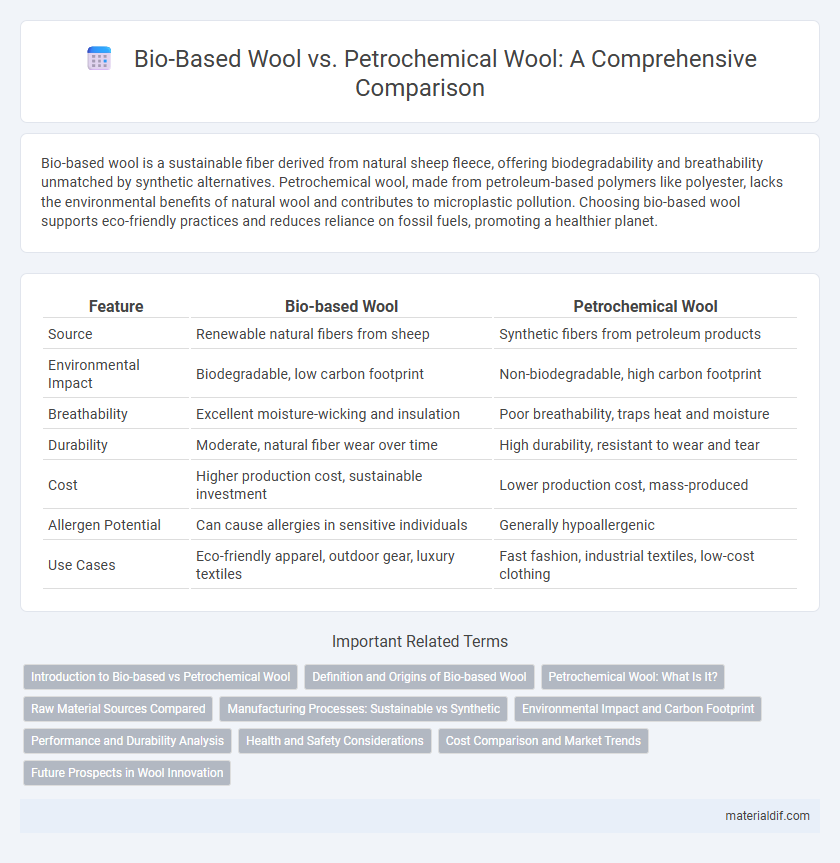Bio-based wool is a sustainable fiber derived from natural sheep fleece, offering biodegradability and breathability unmatched by synthetic alternatives. Petrochemical wool, made from petroleum-based polymers like polyester, lacks the environmental benefits of natural wool and contributes to microplastic pollution. Choosing bio-based wool supports eco-friendly practices and reduces reliance on fossil fuels, promoting a healthier planet.
Table of Comparison
| Feature | Bio-based Wool | Petrochemical Wool |
|---|---|---|
| Source | Renewable natural fibers from sheep | Synthetic fibers from petroleum products |
| Environmental Impact | Biodegradable, low carbon footprint | Non-biodegradable, high carbon footprint |
| Breathability | Excellent moisture-wicking and insulation | Poor breathability, traps heat and moisture |
| Durability | Moderate, natural fiber wear over time | High durability, resistant to wear and tear |
| Cost | Higher production cost, sustainable investment | Lower production cost, mass-produced |
| Allergen Potential | Can cause allergies in sensitive individuals | Generally hypoallergenic |
| Use Cases | Eco-friendly apparel, outdoor gear, luxury textiles | Fast fashion, industrial textiles, low-cost clothing |
Introduction to Bio-based vs Petrochemical Wool
Bio-based wool is derived from natural animal fibers, offering renewable, biodegradable, and sustainable alternatives to petrochemical wool, which is synthesized from non-renewable fossil fuels. Petrochemical wool, typically made from synthetic polymers such as polyester and nylon, poses environmental concerns due to its reliance on fossil fuel extraction and its slow degradation in landfills. The shift toward bio-based wool emphasizes reducing carbon footprints and promoting eco-friendly textile production while maintaining high-performance fabric characteristics.
Definition and Origins of Bio-based Wool
Bio-based wool is a sustainable textile fiber derived from natural, renewable resources such as sheep's fleece, contrasting with petrochemical wool made from synthetic polymers like polyester and nylon. It originates from animal husbandry practices that emphasize environmentally friendly and ethical fiber production without reliance on fossil fuels. This natural wool's biodegradability and renewable origins contribute significantly to reducing carbon footprints in the textile industry.
Petrochemical Wool: What Is It?
Petrochemical wool, often referred to as synthetic wool, is a fabric made from petroleum-derived polymers such as polyester, acrylic, and nylon. Unlike bio-based wool sourced from sheep, petrochemical wool is produced through chemical processes that convert fossil fuels into fibers designed to mimic the texture and warmth of natural wool. This type of wool offers durability and cost-efficiency but raises environmental concerns due to its reliance on non-renewable resources and microplastic pollution.
Raw Material Sources Compared
Bio-based wool is derived from natural fibers obtained from sheep, ensuring a renewable and biodegradable raw material source that supports sustainable agriculture. Petrochemical wool, on the other hand, is synthesized from fossil fuels such as crude oil and natural gas, contributing to environmental pollution and resource depletion. Comparing raw material sources highlights the ecological advantages of bio-based wool through its reliance on renewable, organic inputs versus the finite, polluting origins of petrochemical alternatives.
Manufacturing Processes: Sustainable vs Synthetic
Bio-based wool is produced through environmentally friendly manufacturing processes that emphasize animal welfare and renewable resources, resulting in biodegradable and low-impact fibers. In contrast, petrochemical wool relies on synthetic fibers derived from fossil fuels, involving energy-intensive production that generates non-biodegradable waste and greenhouse gas emissions. Sustainable wool manufacturing integrates practices such as responsible farming, minimal chemical use, and water conservation, setting it apart from conventional synthetic fiber production.
Environmental Impact and Carbon Footprint
Bio-based wool, derived from natural sheep fibers, significantly reduces environmental impact through biodegradability and renewable sourcing, contrasting sharply with petrochemical wool's reliance on fossil fuels and non-renewable resources. The carbon footprint of bio-based wool is notably lower, as sheep grazing can sequester carbon in soil, whereas petrochemical wool production emits high levels of greenhouse gases during polymer synthesis and refining. Sustainable wool farming practices further enhance the eco-friendly credentials of bio-based wool by promoting biodiversity and soil health.
Performance and Durability Analysis
Bio-based wool exhibits superior moisture-wicking properties and breathability compared to petrochemical wool, enhancing comfort during wear. Durability tests reveal that bio-based wool maintains fiber integrity and tensile strength after repeated washing cycles, outperforming synthetic counterparts that tend to degrade and pill. The natural crimp structure of bio-based wool also contributes to better insulation and resistance to wear, providing long-lasting performance in textile applications.
Health and Safety Considerations
Bio-based wool, derived from natural animal fibers, offers superior breathability and moisture-wicking properties, reducing skin irritation and promoting better hygiene compared to petrochemical-based synthetic fibers. Petrochemical wool contains chemicals like acrylonitrile and other additives that may cause allergic reactions or respiratory issues during production and prolonged use. Choosing bio-based wool supports a safer indoor environment by minimizing exposure to hazardous substances and enhancing overall health safety standards.
Cost Comparison and Market Trends
Bio-based wool typically commands a higher price point than petrochemical wool due to its sustainable production processes and natural sourcing, appealing to eco-conscious consumers. Market trends indicate a growing demand for bio-based wool driven by increased environmental awareness and stricter regulations on synthetic fibers, which is gradually narrowing the cost gap. Economies of scale and advancements in bio-fiber technologies are expected to further reduce the cost disparity, positioning bio-based wool as a competitive alternative in the textile industry.
Future Prospects in Wool Innovation
Bio-based wool represents a sustainable advancement in textile innovation by utilizing naturally derived fibers that reduce dependence on petrochemical-based synthetic wool, which is linked to environmental pollution and non-renewable resource depletion. Future prospects in wool innovation include integrating bio-based wool with advanced biotechnology to enhance fiber strength, elasticity, and biodegradability, positioning it as a key material in eco-friendly fashion and technical textiles. Research into circular economy models and carbon-negative manufacturing processes further supports the scalability of bio-based wool, aiming to transform global wool production toward sustainability and reduced carbon footprints.
Bio-based Wool vs Petrochemical Wool Infographic

 materialdif.com
materialdif.com